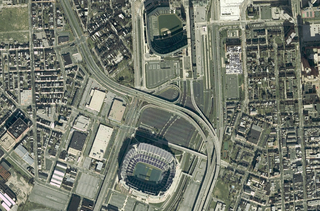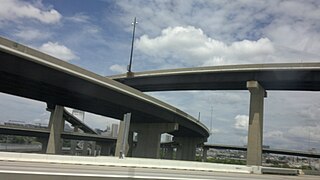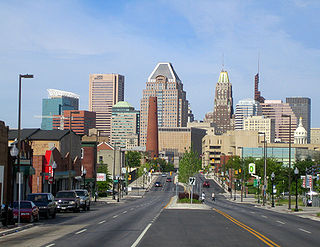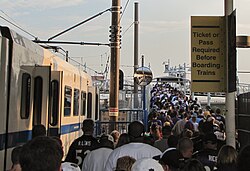
The Baltimore Orioles are an American professional baseball team based in Baltimore. The Orioles compete in Major League Baseball (MLB) as a member club of the American League (AL) East division. As one of the American League's eight charter teams in 1901, the franchise spent its first year as a major league club in Milwaukee, Wisconsin, as the Milwaukee Brewers before moving to St. Louis, Missouri, to become the St. Louis Browns in 1902. After 52 years in St. Louis, the franchise was purchased in November 1953 by a syndicate of Baltimore business and civic interests led by attorney and civic activist Clarence Miles and Mayor Thomas D'Alesandro Jr. The team's current owner is American trial lawyer Peter Angelos.

The Oriole Park at Camden Yards is a baseball stadium located in Baltimore, Maryland. It is the home field of Major League Baseball's Baltimore Orioles, and the first of the "retro" major league ballparks constructed during the 1990s and early 2000s. It was completed in 1992 to replace Memorial Stadium.

M&T Bank Stadium is a multi-purpose football stadium located in Baltimore, Maryland. It is the home of the Baltimore Ravens of the National Football League (NFL). The stadium is immediately adjacent to Oriole Park at Camden Yards, the home of the Baltimore Orioles. Often referred to as "Ravens Stadium" or "The Bank", M&T Bank Stadium officially opened in 1998 and has been praised for its fan amenities, ease of access, concessions and other facilities. The listed capacity for M&T Bank Stadium is 70,745.

The Inner Harbor is a historic seaport, tourist attraction, and landmark of the city of Baltimore, Maryland. It was described by the Urban Land Institute in 2009 as "the model for post-industrial waterfront redevelopment around the world". The Inner Harbor is located at the mouth of Jones Falls, creating the wide and short northwest branch of the Patapsco River. The district includes any water west of a line drawn between the foot of President Street and the American Visionary Art Museum.

Memorial Stadium was a multi-purpose stadium in Baltimore, Maryland, that formerly stood on 33rd Street on an oversized block also bounded by Ellerslie Avenue (west), 36th Street (north), and Ednor Road (east). Two stadiums were located here, a 1922 version known as Baltimore Stadium or Municipal Stadium, or sometimes Venable Stadium, and, for a time, Babe Ruth Stadium in reference to the then-recently deceased Baltimore native. The rebuilt multi-sport stadium, when reconstruction was completed in the middle of 1954, would become known as Memorial Stadium. The stadium was also known as The Old Gray Lady of 33rd Street, and also as The World's Largest Outdoor Insane Asylum.

Interstate 395 (I-395) is an Interstate Highway in the U.S. state of Maryland. Known as Cal Ripken Way, the highway runs 1.33 miles (2.14 km) from I-95 north to Howard Street and Camden Street in Downtown Baltimore, where it provides access to the Inner Harbor and the Baltimore Convention Center. The Interstate also serves the Camden Yards Sports Complex, which contains M&T Bank Stadium and Oriole Park at Camden Yards, homes of the Baltimore Ravens and Baltimore Orioles, respectively. I-395 also serves as the southern terminus of Martin Luther King Jr. Boulevard, an urban arterial that provides a western bypass of downtown Baltimore and connects I-95 with U.S. Route 40, US 1, and I-83. The Interstate is maintained by the Maryland Transportation Authority (MDTA) and, like all Interstates, is a part of the National Highway System.

Baltimore Light RailLink is a light rail system serving Baltimore, Maryland, United States, as well as its surrounding suburbs. It is operated by the Maryland Transit Administration. In downtown Baltimore, it uses city streets. Outside the central portions of the city, the line is built on private rights-of-way, mostly from the defunct Northern Central Railway, Baltimore and Annapolis Railroad and Washington, Baltimore and Annapolis Electric Railway. In 2021, the system had a ridership of 2,718,100, or about 9,900 per weekday as of the second quarter of 2022.

The Camden Yards Sports Complex is located in the center of Baltimore, Maryland. The complex is composed of multiple buildings and stadiums including Oriole Park at Camden Yards and M&T Bank Stadium. The two stadiums are home to the Baltimore Orioles of Major League Baseball and the Baltimore Ravens of the National Football League. The complex still houses the recently closed Sports Legends Museum at Camden Yards. Along with the Sports Legends Museum, the Babe Ruth Birthplace and Museum is located approximately two blocks from the main entrance of Camden Yards at Eutaw Street. Geppi's Entertainment Museum is also located in Camden Station, atop the Sports Legends at Camden Yards. In addition to the sports facilities, it is also a location for community events such as the Dew Tour's Panasonic Open in June 2007 and 2008, the Baltimore Marathon, and the African American Festival which is held every year.

Sports Legends Museum at Camden Yards was a non-profit sports museum in Baltimore, Maryland, United States, owned and operated by the Babe Ruth Birthplace & Museum. It opened on May 14, 2005, with Julia Ruth Stevens, the daughter of celebrated baseball player Babe Ruth, in attendance. After ten years of operation the museum closed abruptly on October 12, 2015 after failing to reach an agreement with the Maryland Stadium Authority for the continued use of Camden Station. The 22,000-square-foot (2,044 m2) museum was adjacent to the main gate of Oriole Park at Camden Yards and had artifacts and interactive exhibits profiling Maryland’s sports history. Exhibits included such area teams as the Baltimore Orioles, Baltimore Ravens, Baltimore Colts, Maryland Terrapins, Baltimore Elite Giants, Baltimore Black Sox, and the Baltimore Blast.
The Maryland Stadium Authority, MSA, was created by Chapter 283, Acts of 1986 Maryland General Assembly. Its initial mission was to return the National Football League (NFL) to Baltimore. Maryland sought a new football team after former Baltimore Colts owner, Robert Irsay, moved the Colts out of the city in the middle of a snowy night on March 29, 1984. The Authority is a public corporation of Maryland which is authorized to issue tax-exempt bonds for financing its operations. The proceeds from the sale of those bonds and any other revenues collected are deposited in the Maryland Stadium Authority Financing Fund.

Westport is a neighborhood in south Baltimore, Maryland. Westport is a majority African-American neighborhood that has struggled with crime, housing abandonment, and unemployment in the past decade. The neighborhood is bordered by the Middle Branch of the Patapsco River on the east, the city neighborhoods of Cherry Hill, Brooklyn and the southwestern Baltimore County community of Lansdowne to the southwest, Hollins Ferry Road and the Mount Winans and Lakeland neighborhoods to the west, and Interstate 95 to the north, along with the South Baltimore communities of Federal Hill and Otterbein. The Baltimore–Washington Parkway runs through the middle of Westport and intersects with Interstate 95, the main East Coast super-highway, north to south, Maine to Florida.

Ridgely's Delight is an historic residential neighborhood in Baltimore, Maryland, United States. Its borders are formed by Russell and Greene Streets to the east, West Pratt Street to the north, and Martin Luther King Jr. Boulevard from the western to southern tips. It is adjacent to the University of Maryland, Baltimore, Oriole Park at Camden Yards, and M&T Bank Stadium. It is situated a short walk from MARC Train and the Light Rail's Camden Station, which has made it a popular residence of Washington, D.C. and suburban Baltimore commuters. It is within a 5-minute walk of both Oriole Park at Camden Yards and M&T Bank Stadium and a 10-minute walk from Baltimore's historic Inner Harbor.

Downtown Baltimore is the central business district of the city of Baltimore traditionally bounded by Martin Luther King, Jr. Boulevard to the west, Franklin Street to the north, President Street to the east and the Inner Harbor area to the south.

The Coldstream-Homestead-Montebello community, often abbreviated to C-H-M, is a neighbourhood in northeastern Baltimore, Maryland. A portion of the neighborhood has been listed on the National Register of Historic Places as the Coldstream Homestead Montebello Historic District, recognized for the development of a more suburban style of rowhouses.

Camden Station, now also referred to as Camden Street Station, Camden Yards, and formally as the Transportation Center at Camden Yards, is a train station at the intersection of South Howard and West Camden Streets in Baltimore, Maryland, and is adjacent to Oriole Park at Camden Yards. It is served by MARC commuter rail service and local Light Rail trains. Camden Street Station was originally built beginning in 1856, continuing until 1865, by the Baltimore and Ohio Railroad as its main passenger terminal and early offices/ headquarters in Baltimore and is one of the longest continuously-operated terminals in the United States. Its upstairs offices were the workplace of famous Civil War era B&O President John Work Garrett (1820–1884). The station and its environs were also the site of several infamous civil strife actions of the 19th century with the Baltimore riot of 1861, on April 18–19, also known as the Pratt Street Riots and later labor strife in the Great Railroad Strike of 1877.

Ednor Gardens-Lakeside is a large community in northeast Baltimore, Maryland. It is bounded by 33rd Street to the south, Hillen Road to the east, Ellerslie Avenue to the west, and Argonne Drive, The Alameda, Loch Raven Boulevard, and Roundhill Road to the north. Ednor Gardens was part of a large planned community that was built out from the 1920s through the 1950s by Edward Gallagher, one of Baltimore's most prolific homebuilders at the time. It is notable among its neighbors for the quality of the homes and extensive landscaping. Until it was torn down in 2002, Memorial Stadium was located in Ednor Gardens-Lakeside.

Charles Center is a large-scale urban redevelopment project in central Baltimore's downtown business district of the late 1950s and early 1960s. Beginning in 1954, a group called the "Committee for Downtown" promoted a master plan for arresting the commercial decline of central Baltimore. In 1955, the "Greater Baltimore Committee", headed by banker and developer James W. Rouse, joined the effort. A plan was developed by noted American urban planner and architect David A. Wallace, (1917−2004), strongly supported by Mayors Thomas L. J. D'Alesandro, Jr. (1947−1959) and Theodore R. McKeldin, and many in their administrations, which formed the basis of a $25 million bond issue voted on by the citizens of Baltimore City during the municipal elections in November 1958. The architects' view of the overall Charles Center Redevelopment Plan with the conceptions of possible buildings, lay-out and plan that was publicized to the voters that spring and summer before, only slightly resembles the actual buildings and designs that later were really constructed by the mid-1970s.

Baltimore is the most populous city in the U.S. state of Maryland, fourth most populous city in the Mid-Atlantic, and the 30th most populous city in the United States with a population of 585,708 in 2020. Baltimore was designated an independent city by the Constitution of Maryland in 1851, and today is the most populous independent city in the United States. As of 2021, the population of the Baltimore metropolitan area was estimated to be 2,838,327, making it the 20th largest metropolitan area in the country. Baltimore is located about 40 miles (64 km) north northeast of Washington, D.C., making it a principal city in the Washington–Baltimore combined statistical area (CSA), the third-largest CSA in the nation, with a 2021 estimated population of 9,946,526.

Hollins Market is a neighborhood in the Sowebo area of Baltimore. It takes its name from the Hollins Market, the oldest public market building still in use in Baltimore City, which is located in the heart of the neighborhood.

















